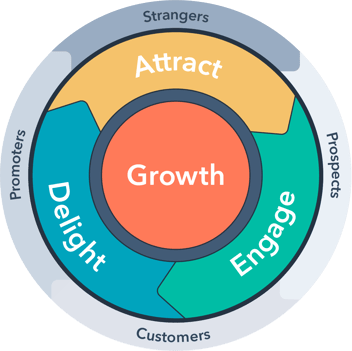If you’ve spent five minutes online Googling how to grow your business, chances are you’ve seen the term ‘lead generation’ bandied around without much explanation.
Everyone knows that someone who has made a purchase is a customer, and someone who has never heard of your company is a stranger. But what about all the people who are aware of your business but are not yet ready to buy?
These are your leads.
Your marketing strategy should include two fundamental goals: to improve lead generation and to increase your lead-to-customer conversion rate.
Inbound marketing specialises in achieving these goals by bridging the gap between sales and marketing, delivering high-quality content that delights your leads. Our blog explores five ways inbound does this.
2. Nurturing Leads into Customers
4. Utilising Multiple Marketing Channels
1. Attracting Leads Online
Websites are powerful tools for lead generation; this is well known. In fact, 83% of B2B marketers rated their company website as effective for lead generation, with 23% going further and saying it is “very effective”.
A website provides your leads with everything they need to decide whether they want to become a customer, but before you think about that, you need to take a step back and look at how easy it is to actually find your website.
When your ideal customer uses a search engine to try to source a product or service your business provides, they will most likely be met with millions of search results, and the only ones that really matter are on page one.
Websites featured on the first page of a Google search account for almost 95% of the web traffic that comes from that search. So, if you want to improve lead generation, you need to be on the front page.
How you achieve this comes down to your search engine optimisation (SEO) strategy and how tailored your content is to specific keywords.
You’ll need to identify which search terms your customers use to find you business, product or service, and optimise each piece of your content to include this keyword. To do this include your keyword in the following places:
- The page URL
- The meta title
- The header tags
- Image alt-text
- The body content of a page
2. Nurturing Leads into Customers
Once your SEO strategy has helped make your website more visible, it’s time to look at the content your potential customers are greeted with. You’ll want a high-quality homepage that makes a great first impression, but beyond this, your website needs to be full of lead-nurturing content.
The first step to creating this content is launching a blog. This allows you to create regular content that educates your leads and provides a level of value that keeps them coming back for more.
Alongside this, by optimising each blog for a keyword, every time you publish one you create a new pathway for people to come across your business, as evidenced by the fact that companies with blogs benefit from 55% more website visitors.
In order to properly nurture your leads, you’ll need to learn more about them so you can share more content with them. To do this, inbound marketing uses downloadable offer content.
Downloadable offers are hosted on landing pages and can be anything from eBooks to infographics. The only requirement is that they provide exceptional value that can’t be found elsewhere. In return for this content, you can request that leads share details such as job titles, company names or email addresses via a form, before they can download the content
In traditional outbound marketing, at this point, the information gathered would be handed over to the sales team. However, inbound marketing recognises that many people aren’t ready to purchase at this point.
With this being the case, inbound uses automated emails to continue the nurturing process and provide more educational content until marketing-qualified leads (MQLs) become sales-qualified leads (SQLs). This may seem like more effort, but the results speak for themselves, with the average inbound lead costing 61% less than the outbound alternative.
3. Creating Calls-to-Action
We’ve spoken about the benefits of nurturing content, but how do you move a visitor on your website from a blog to a downloadable content offer? The answer is by using calls-to-actions (CTAs).
CTAs are a crucial element of inbound marketing. The clickable buttons can be hosted on any page of your website and linked to landing pages that host offers. In this way, CTAs move your leads through the buyer’s journey, bridging the gap between a website visitor and website customer.
It is often the simplest elements of your marketing that take the most time to perfect and CTAs fall squarely into this bracket. While they may need no more content than ‘download here’ or ‘sign up for your free trial’, their conciseness means that every word has to deliver an impact.
When creating them, CTAs should be:
- Visually impactful
- Ideally no more than five words
- Action-orientated, beginning with a word like ‘download’
- Located in an easy-to-find location, such as the bottom of a blog post
- In a colour that both contrasts and matches your design
- Large enough to be seen clearly, but not so large as to distract from your content
- Easy to understand
4. Utilising Multiple Marketing Channels
So far much of our lead generation advice has revolved around what you can do on your website, but it is important to remember that there is more than one marketing channel you can make use of.
The most obvious collection of platforms inbound marketing uses to improve lead generation is social media. Twitter, Facebook, LinkedIn and Instagram are some of the most popular channels you should consider using, each with their own benefits.
Social media channels provide another opportunity to share the valuable content you are creating as part of your inbound marketing strategy. The purpose of this content is to engage your leads, so what better place to do that than on social media, where you can actually speak to them directly.
This kind of interaction goes a long way to positioning yourself as a trustworthy brand and industry leader. Perhaps this is why 61% of organisations on social media report a positive impact on revenue growth.
Since we’re speaking about other marketing channels, it’s worth revisiting the idea of email marketing too and looking at it in a little more detail. It is widely accepted that email is one of the most valuable marketing channels, with three-quarters of companies agreeing that email offers "excellent" to "good" return on investment (ROI).
This is because email keeps leads engaged in your business without pressuring them into a decision. Such practice regularly backfires, as seen by the fact that 61% of B2B marketers send all leads directly to sales, but only 27% of those leads will be qualified.
5. Employing Personalisation
Inbound marketing improves lead generation by building a relationship via engaging content with everyone who comes across your website. What better way to do this than by personalising your marketing to individual leads.
No, this doesn’t mean writing a unique email for each of the thousands of people in your contact database. If you have a strong inbound system and use advanced marketing software such as HubSpot, you can incorporate ‘smart content’ that drives lead generation.
Smart content allows you to set aspects of your website or emails to change depending on who is interacting with it. This is done by using the information you gather when people sign up to your services, make a purchase, or download a piece of content through a form.
What impact does this have? Well, if you know someone’s first name, you can ensure every automated email they receive addresses them by name. Directing marketing materials to a named person is one of the simplest forms of personalisation you can implement. It may not seem like much, but the results are amazing – marketers see an average increase of 20% in sales when using personalised experiences.
The same applies to your digital presence. If you know the industry your website visitor works in, you can use smart content to change areas of text to tailors it to your user. This personalisation can be as simple as swapping the term ‘business’ to ‘law firm’, if you know the visitor works in the legal sector.
With these five inbound marketing techniques, you can transform your business by driving increased lead generation.
If you’d like to learn more about inbound marketing, book a free Marketing Assessment with one of our experts today.




